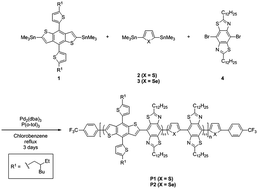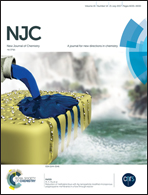Photovoltaic properties of novel thiophene- and selenophene-based conjugated low bandgap polymers: a comparative study†
Abstract
In this study, we investigated the photovoltaic properties of newly synthesized low bandgap conjugated polymers, poly(4-(4,8-bis(5-(2-ethylhexyl)thiophen-2-yl)benzo[1,2-b:4,5-b′]dithiophen-2-yl)-8-(5-(2,6-didodecylbenzo[1,2-d:4,5-d′]bis(thiazole)-4-yl)thiophen-2-yl)-2,6-didodecylbenzo[1,2-d:4,5-d′]bis(thiazole)) (P1) and poly(4-(4,8-bis(5-(2-ethylhexyl)thiophen-2-yl)benzo[1,2-b:4,5-b′]dithiophen-2-yl)-8-(5-(2,6-didodecylbenzo[1,2-d:4,5-d′]bis(thiazole)-4-yl)selenophen-2-yl)-2,6-didodecylbenzo[1,2-d:4,5-d′]bis(thiazole)) (P2). P1 is a thiophene-based conjugated polymer (TCP), and P2 is a selenophene-based conjugated polymer (SCP). These two different conjugated low bandgap polymers were characterized by NMR and gel permeation chromatography. The physical properties of the polymers were studied by thermogravimetric analysis and conductivity. Moreover, we also investigated the optical, electrochemical and morphological properties of both polymers by UV-vis spectroscopy, cyclic voltammetry and atomic-force microscopy (AFM), respectively. Later, we studied the photovoltaic properties of both low bandgap polymers blended with PC61BM in different ratios with different thicknesses. In addition, post thermal annealing at different temperatures for both polymers was investigated, and the results show that P2 (SCP) exhibited stronger molecular orientation properties as compared to P1 (TCP).



 Please wait while we load your content...
Please wait while we load your content...